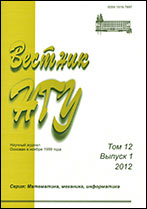|
|
Vestnik Novosibirskogo Gosudarstvennogo Universiteta. Seriya Matematika, Mekhanika, Informatika, 2013, Volume 13, Issue 2, Pages 119–125
(Mi vngu147)
|
 |
|
 |
This article is cited in 1 scientific paper (total in 1 paper)
Theoretical and Experimental Studies of Specific Energy of Mechanical Fracture of Sea Ice
V. G. Tsuprik
Far Eastern Federal University, Vladivostok
Abstract:
The work showed results of explores kinetic and physical processes of fracture of marine polycrystalline ice when the structures embedding in the edge of the ice field. The array of ice is seen as elastic-frail body. The destroyed ice in the form of an ice crumb behaves like elastic-plastic body. Transition of ice from not destruction in the destruction of the condition occurs on physical surface of fracture, which is the surface of a strong gap for stress and strain, and shared the half-space (an array of ice) on two zones, where material have different physical state. Shows that the embedding of rigid structures in the ice field is a cyclic process of fracture layer-by-layer of the ice. The amount of cycles of a continuous layer-by-layer fracture of ice is depends from a reserve of kinetic energy of ice field and from her consumption during in the process of fracture of ice in his contact with surface of structure. The theoretical consideration of the dynamic introduction a solid body in array of ice showed continuous periodical (cyclic) nature changes the load ice and of all physical parameters describing this process. Quantitatively, this process can be described by specific energy of mechanical destruction of ice that can be determined experimentally.
Keywords:
sea ice, ice field, mechanism of cyclic crushing; ice load, specific energy of mechanical fracture ice.
Received: 01.07.2012
Citation:
V. G. Tsuprik, “Theoretical and Experimental Studies of Specific Energy of Mechanical Fracture of Sea Ice”, Vestn. Novosib. Gos. Univ., Ser. Mat. Mekh. Inform., 13:2 (2013), 119–125
Linking options:
https://www.mathnet.ru/eng/vngu147 https://www.mathnet.ru/eng/vngu/v13/i2/p119
|

|




 Contact us:
Contact us: Terms of Use
Terms of Use
 Registration to the website
Registration to the website Logotypes
Logotypes








 Citation in format
Citation in format 
